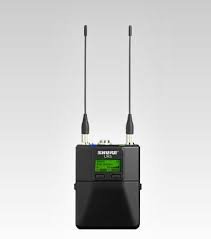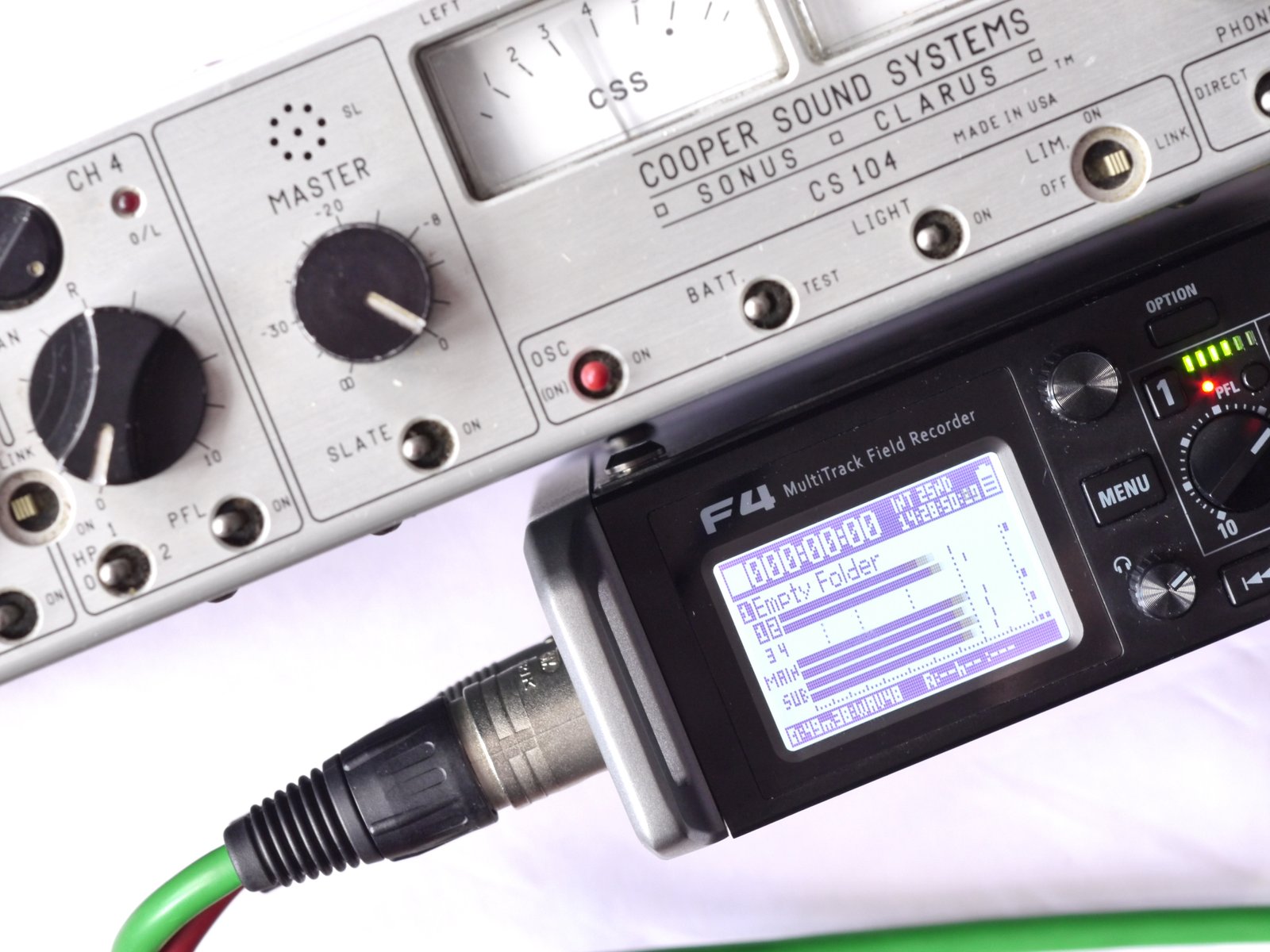Shure have been a big name in the world of wireless for quite some time now. When handhelds were needed that could work across Cardiff’s Millennium Stadium, Mr. Shure got the business, because his handhelds did the business.
However one area that Shure haven’t been so active in is that of location sound. From ENG and documentaries to drama and film there’s a world of sound that relies on or at least has to have the option of dragging your kit away from the comfort of 220 volts at 50Hz. Yes it’s the world of battery powered receivers.

For this review I got to play with some new toys at the pro end of Shure’s range including the new UR5 battery powered diversity receiver.
So let’s start at the ‘camera’ end so to speak. And Shure are very definite that this is a product to be used with a camera — the main audio output has a little picture of a camera underneath it. The UR5 is a small well finished metal box, roughly half of which contains the two AA batteries and the rest the electronic goodies that let you hear people even when you are not connected to them by a wire. It’s magic really.
One of the things that sorts the pros from the wannabees is powering, stuffing Duracells (other expensive batteries are available) into a radio mic receiver can be costly and pros are notoriously mean, not to say stingy. My UR5 came with the optional Anton Bauer cradle to enable powering from a camera and Shure have a custom Li-On battery pack which I haven’t seen but they claim will power your receiver for eight hours.
To do pro wireless you need diversity, you need robustivity, you need flexibility and ease of use and you need as much of that wireless magic as you can get. The UR5 is an antenna diversity system rather than a dual tuner, and offers hundreds of possible frequencies, neatly arranged in 26 groups. Audio output is on a nice locking TA3 connector, with mic and line levels available and the option to send some tone — great for annoying camera operators. The receiver has an easy to use two position on/off switch and a separate headphone monitor output. Along side the LCD you get LEDs for signal strength and battery condition on the top plate where they are easy to check with the receiver buried in your bag.

The UR5 has a couple of neat tricks up its sleeve. It `syncs’ for itself and scans the rf neighbourhood looking for free channels or even the group with the most free channels. When you flip down the battery lid you get access to the function buttons. Exit, Enter and Scan and between the last two a little red IR window labelled `Sync’.
So first you turn off your transmitters and let the UR5 scan the spectrum, when you’ve find a nice empty channel use the sync function to automatically tune your sync enabled transmitter to instantly syncronise with the reciever. `Darn o teisen’, as we say in Wales (other terrible mistranslation of English idioms are available), piece of cake. If you have a number of systems to set up, you can identify the best group and sequentially scan and sync in your systems in double quick time.
Even more powerful is the full fat scan option. This scans the RF band in 25kHz increments and produces an on screen zoomable spectrum display which you can navigate to find the best spot for your mic. The UR5 retains the scan information in memory even after power down. How clever is all that? As the fight to for every free slice of spectrum gets ever harder having a scanner in your radio mic receiver could well save your bacon and your eggs working in todays congested RF arena.
So much for the receive end what about the transmitters. Well I had a jumbo pack of four options from Shure starting with the standard UR1. Powered by two AA batteries or a Shure rechargeable pack the UR features the IR sync option, an lcd display with channel and frequency information alongside a custom memory function and a battery level display. Tuning is in 25kHz steps if you want to do it manually. The mic input is a locking TA4 connector and there’s a top mounted on/off switch with associated green power led. Both the UR1 and UR5 are comfortably dimensioned, hand sized and finished to feel good in operation. However sometimes you need a smaller option and then you reach for a UR1M (M for micro) which packs most of the same features into a smaller case. So small in fact it can be sewn into Beyonce’s top hat for her performance at the Oscars, I kid you not. Where’s the fun in that I say, but it makes the point. The UR1M weighs only 88 grams with batteries against 130 for the UR1, despite that Shure claims identical audio performance and that seemed borne out by my side by side testing. The most noticable user differences are the lack of the sync feature on the UR1M, a smaller lcd with less info and the absence of the power on led.
Talking of the Oscars, one great option for the system is MTx — multiple transmitters. This allows you to set up a list of transmitters in your UR5 reciever that you can cycle through without having to change detail settings. Using the scan function you can populate your MTx list automatically and then sync your transmitters to the list. You can even use the IR sync abilities to copy and paste an MTx list from one receiver to another and have multiple entries for the same receiver but with different volume settings on the output.
When you survey all this wondrous setability you realise Shure have mixed some of it from their mains powered line, like IR syncing with functionality from their Wireless Workbench software — scanning, and added some entirely new ingredients like MTx.
Alongside the UR1 and UR1M bodypacks I also got to play with the UR2 handheld and the UR3 plug on transmitter. Shure R is nothing if not a system! The UR2 came out of the box with an SM58 capsule (the capsules are interchangeable as we shall see) and offers all the features of the UR1 including sync, there’s an lcd with the same information though not an led to show power on.

The UR3 is the first plugon from Shure, like the UR2 it’s powered by two AA batteries and features the familiar lcd screen but like the UR1M doesn’t offer sync. Again both these transmitters are very well made and feel utterly professional. The UR3 has a recessed on switch which means that audio engineers who bite their nails (that’s all the men and most of the women — it’s a stressful occupation you know) will sweat to operate when they have to grab a hand held because Beyonce’s hat has fallen off. It’s great to have a plug on handy and the UR3 offers +12 and +48 phantom power alongside a high pass filter and the ability to deploy your favourite dynamic mics. And in a stroke of genius there are ten memories in which you can store the settings including gain, phantom and filter frequency for your favourite mics. Having reached the great age of eleventy one my eyes are not what they used to be and I appreciated the backlight of the UR3, I found the display on the UR1 a little tricky to read without backlighting. And talking of lighting the UR3 has very handily but discretely placed leds for power and level — you can checking them while talking into the mic, what will they think of next?
Last but not least Shure sent me their latest capsule for the UR2 the VP68, their first omni capsule for their radio range. Primarily an interview mic the VP68 sounds very different to the 58 (the world’s most heard cardiod I should think), and I was really impressed. I stuck a hundred quid dynamic interview omni into the UR3 plugon and ran them side by side. The VP68 was less congested and all round a much better sound. I take the gloves off and replace the dynamic with a German capacitor instrument omni costing four times as much as the VP68. An interesting comparison – you would prefer the Germans for instruments and the VP68 for close speech – which it what it is designed for. A pretty good showing.
To some it all up the Shure R series is a comprehensive, high quality system that offers everything you need to build a professional system. The UR5 has features that set new standards in spectrum scanning and ease of use with multiple transmitters. Whether a poor old single camera operator will have time to get the best out of all of these… is their problem, you should have hired a sound mixer.
There are still choices to make my Micron radio kit has better rf performance but that kit comes with two screwdrivers and a very hairy shirt to make changes to your settings. To be fair Micron do have a model with buttons and an lcd display but the depth of the sophistication of the Shure system is pretty impressive. For people working under pressure, and aren’t we all, the feature set might well deliver you the best chance of finding and operating a useable frequency in the brave new world the government are squeezeing us into in channel 38. We all know that is going to be a nightmare and if you work in congested rf environments with multiple transmitters and are not afraid of menus the Shure R series has an awful lot to offer.
